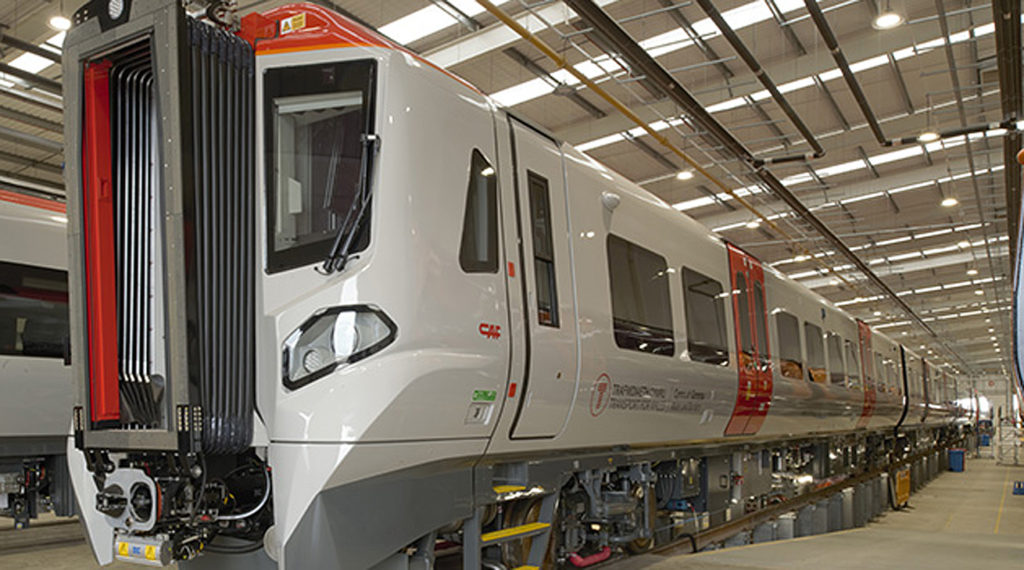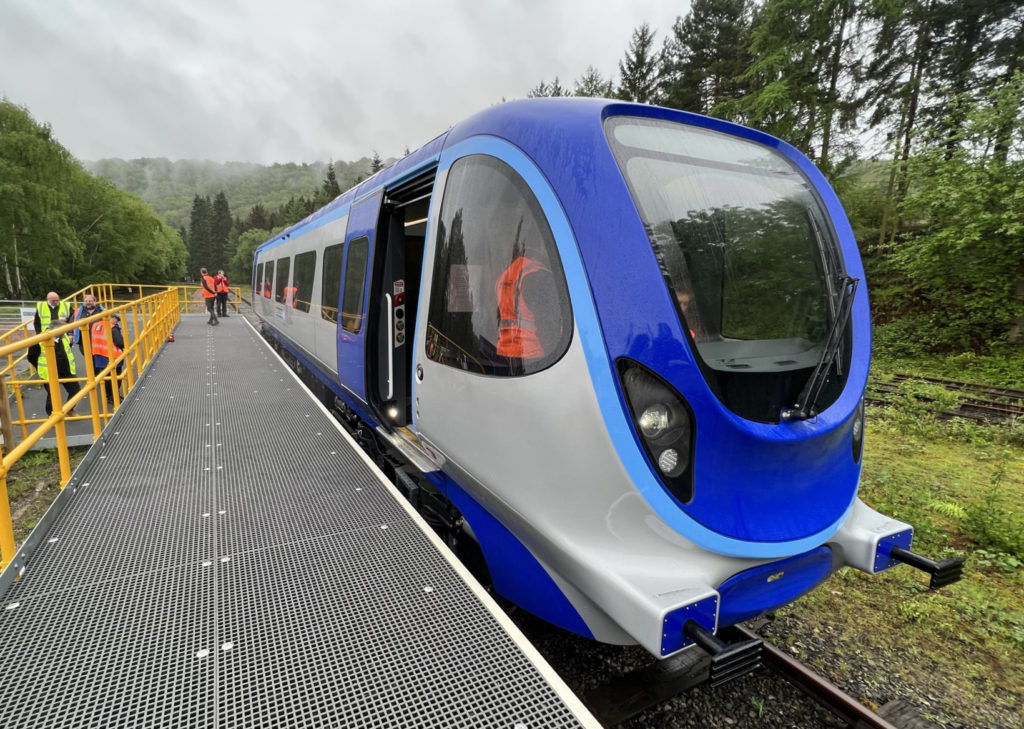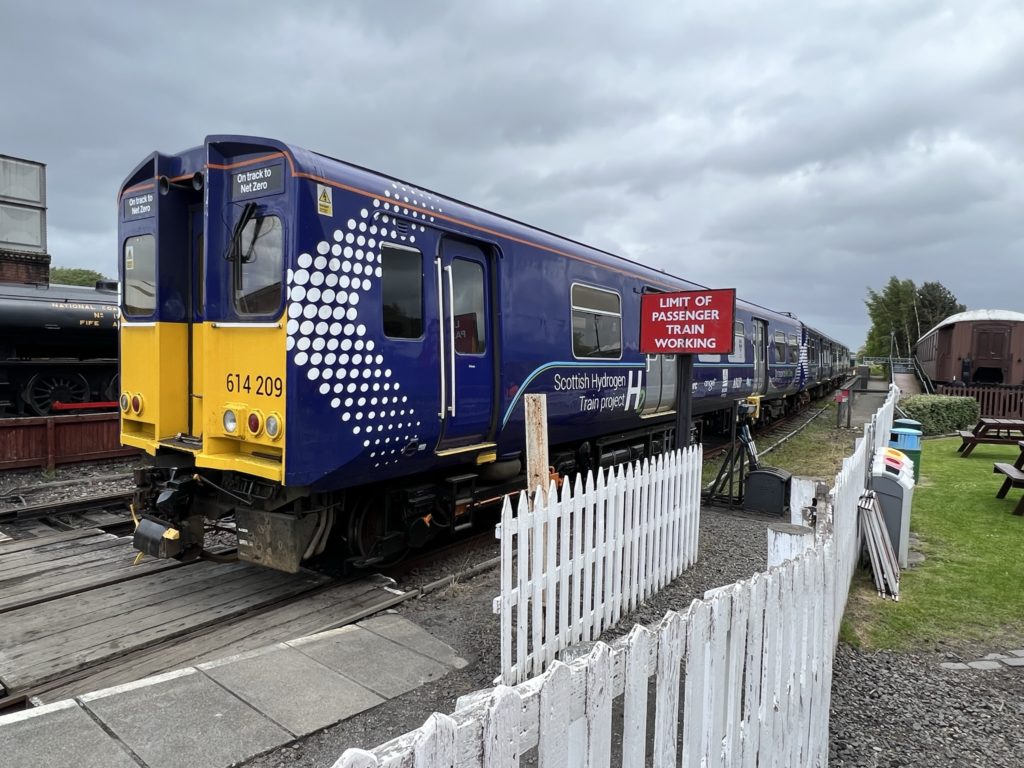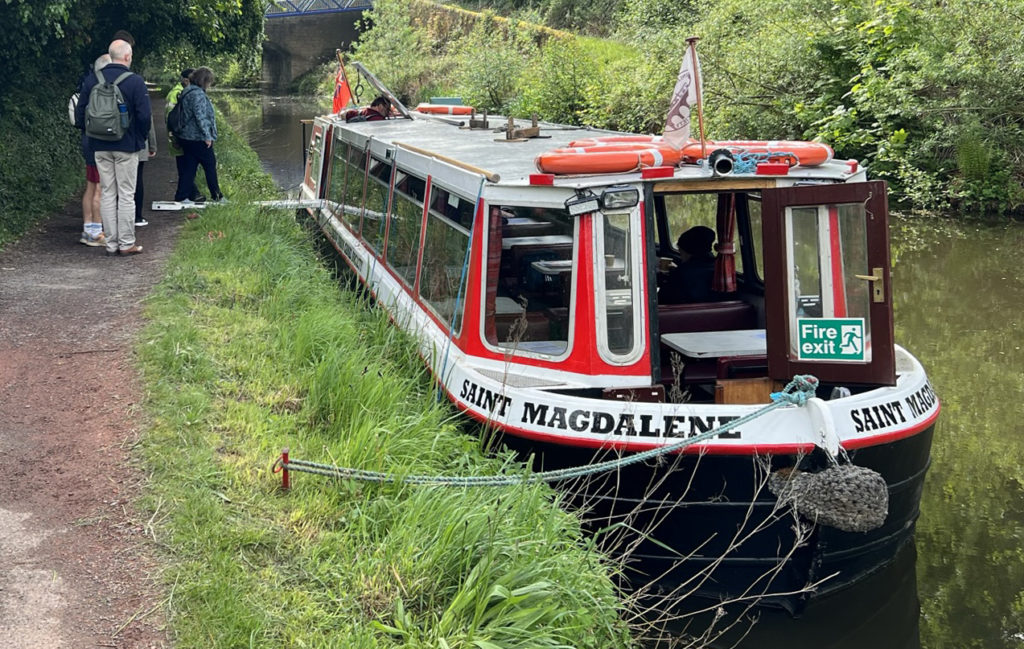While “race around” may be a slight exaggeration, the IMechE’s Annual Technical Tour (ATT) always has a demanding schedule. This year’s tour, the first since 2019, travelled from Cardiff to Glasgow via Shrewsbury and Liverpool. Its 30 participants visited 14 sites of railway and historic interest by using 11 trains, 13 coach trips, and a canal boat.
As always, there was much to learn. On this tour, it was impressive to see how three devolved administrations had developed optimum infrastructure/rolling stock solutions for their requirements.
Sunday AM – Cardiff Canton
The tour started at Cardiff Canton depot to see trains old and new. Transport for Wales (TfW) has ordered 11 Class 231 Stadler-built FLIRT (Fast Light Intercity and Regional Train) diesel units of which six had been delivered at the time of the visit. These are wholly articulated units with four passenger cars and a seven-metre-long diesel power car in the centre of the train. This has four independent engine bays each with a Deutz 480kw V8 engine that meets stage V emission limits.
The party also had the opportunity to examine a set of ex-LNER Mark 4 coaches. TfW currently has three such sets of which two are needed to operate its thrice-daily each way Holyhead to Cardiff service.
Also to be seen were the Class 150, 153, and 769 DMUs based at the depot. The replacement of most of these units by TfW’s new train fleets will transform maintenance at Cardiff and present a significant transitional challenge.

Sunday PM – BMR
The 4.5-mile-long Brecon Mountain Railway (BMR) operates between Pant, just north of Merthyr Tydfil, and Torpantau, 1313 feet above sea level. It was built on the trackbed of the standard gauge line Brecon and Methyr Railway which closed in 1964. Its first section opened in 1980 with the line to Torpantau completed in 2014.
The tour group travelled on a train hauled by 2-6-2 Locomotive No 1, Santa Teresa, built in 1897 by Baldwin of Philadelphia. It was originally a 2-6-0 metre-gauge locomotive operating in Brazil, then was converted to 2ft 6-inch gauge to work at a Sugar Mill. It was brought to the UK in 1990 and, in 2002, was purchased by the BMR which substantially rebuilt it and converted it to its 1ft 11 ¾ inch gauge for use since 2019.
On the way back to Cardiff the party walked along the Penydarren Tramroad. This was thought to have the first iron rails made for flanged wheels. These were laid on stone block sleepers that can still be seen. Trevithick’s locomotive was the first engine to pull a load on a railway when it ran on it in 1804.
Monday AM – TfW
The new £100 million Metro depot under construction close to Taffs Well station is a visible sign of the Welsh Government’s intent to transform its Core Valley Lines (CVL) rail services. At the adjacent Control Centre, site presentations and new train mock-ups showed how CVL services and elsewhere in Wales will be revamped over the next few years.
TfW took ownership of the CVL lines from Cardiff to Aberdare, Coryton, Merthyr Tydfil, Rhymney, Treherbert, and Radyr in March 2020. Immediate actions to address the lack of capacity were increasing its single-car class 153 fleet from eight to 23, and using class 37 hauled coaches on the Rhymney line.
These are the first steps in a £750 million programme to transform CVL services as part of the Welsh Government’s aspirations for modal shift to public transport, which also includes innovative bus solutions and active travel.

The CVL electrification totals 170 single-track-kilometres and includes widespread use of permanently earthed sections (PES) and catenary free sections (CFS). This saves around £200 million by avoiding 60 track/civil interventions and electrification at complex locations. However, it requires the use of Battery EMUs which are significantly more expensive to buy and run than EMUs. Complex power modelling has been undertaken to ensure battery state of charge is maintained and that power limits are not exceeded.
These routes will be operated by 36 x 3-car Class 398 Stadler Citylink tram trains as well as 7 x 3-car and 17 x 4-car Class 756 Stadler FLIRT Tri Mode units. The 100 km/h Class 398s are powered by 25kV and batteries. They will run to Treherbert, Aberdare and Merthyr Tydfil with the intention that these services will be extended onto 15-miles of new Cardiff area street tramways. The 120 km/h Class 756 units have one engine and three battery packs in their centre power cars. They will run from Rhymney/ Coryton to Penarth/Barry and Bridgend.
The new CVL services will be fully operational by 2025. As well as offering new trains, these will double the frequency of the current timetable.
TfW is also procuring: 51 x 3-car and 26 x 3 car CAF built class 197 DMUs for use on North Wales, Cambrian, and Marches services; 5 x 3-car class 230 Vivarail units for the Wrexham to Bidston route and has acquired an additional 5 x 5-car sets of Mark 4 coaches for Manchester to Cardiff services.
The group was impressed to learn how train travel throughout Wales is about to be transformed. Rail Engineer will return to this topic soon.
Monday PM – Port Talbot
The scale of a steel plant such as the Tata Steel Works at Port Talbot has to be seen to be fully appreciated. It employs 3,800 staff and has two blast furnaces with a maximum combined annual capacity of 5 million tonnes, and produces 3.8 million tonnes of rolled steel products per annum. The tour, however, had not come to see the steel works but the operation of the plant’s railway.
This transports two hot metal torpedoes over the 1.5 miles between the blast furnaces and steel mills. Of this, 0.5 miles has a 1 in 60 gradient. The torpedoes have a combined weight of 1,200 tonnes, of which 800 tonnes is molten metal. They have no brakes so are pushed up the gradient. Each one is carried on four three axle bogies and so has a 50-tonne maximum axle load.

The plant has 16 locomotives, five of which are diesel hybrid locomotives. The original 1953-built diesel locomotives have a 384-kW diesel engine which compares with a 55-kW engine in the new 90-tonne hybrid Clayton CBD90 locomotive. With maximum power output only needed for the few minutes to go up the plant’s maximum gradient, the hybrid locomotives only require an engine with a seventh of the power of original locomotives. The traction batteries are relatively cheap and heavier lead acid batteries which weigh 16 tonnes. This extra weight is an advantage as it helps ensure the locomotive has the required adhesion for its heavy load.
Tuesday AM – CAF
Having heard of its plans for new rolling stock, a trip to the new CAF factory at Newport to see TfW’s Class 197 DMUs being built was the next port of call. Construction of this new plant started in July 2017 and was completed in September 2018. The first train to be built there, a class 195 DMU for Northern Rail, entered service in August 2019. The plant is currently building Class 196 DMUs for West Midlands and Class 197 DMUs for TfW.
Bodyshells for these units are shipped from Bilbao to Bristol, and the plant receives 10 lorries worth of parts and components per day from Europe. On arrival, much of this is stored in three off site warehouses. Wire harnesses that used to be made in Spain are now produced at the Newport plant. These weigh 850 kg and 5- 10% of their wiring is spare. It takes five people about a week to produce a harness which equates to about 300 man-hours work.

The plant has five zones which progressively build up the bodyshells, which spend seven days in each zone where about 1,500 man-hours work is done. All work is controlled by a digital factory app which tracks all stages of work and issues work instructions. The CAF plant at Newport is another topic to which we will return.
Tuesday PM – ROC and Pullman
The tour was split into two for short visits to the Wales Railway Operations Centre (WROC) and the TfW Pullman Rail workshop at Cardiff Canton.
The visit to the WROC included a presentation on the integrated control centre in which Network Rail and TfW staff provide operational control, fleet management, and passenger information from common data sources. There was also an opportunity to see signallers monitor automatically controlled train movements on their workstations and to try to relate the schematic signalling diagrams to the reality of the world outside.
The WROC replaced Cardiff Signalbox when the Cardiff Area Signalling Renewals project was completed over the 2016 Christmas festive period. It has workstations for the Cardiff Valley Lines, Cardiff main line, and Vale of Glamorgan. In addition, WROC also controls 33 miles of the North Wales line between Shotton and Colwyn Bay, and the line between Crewe and Shrewsbury. The last two sections were low-cost modular resignalling schemes that, on commissioning, were recontrolled to the WROC.
Visiting Pullman Rail was quite a contrast to the WROC. Here the group observed bogie overhaul and repairs that included welding, shot blasting, non-destructive testing, wheelset reprofiling, overhaul of suspension tubes, axle boxes, and final drive gearboxes at Pullman’s well-equipped facilities. It could be seen that the company had a wide range of customers including ScotRail, East Midlands Railway, South Western Railway, and London Underground’s Piccadilly and Jubilee lines.
Pullman Rail became part of the TfW group who acquired the company from COLAS Rail UK in August 2021 to support the introduction of its new rolling stock programme. It was clear that Pullman has a full order book as there are now relatively few UK companies that provide its services.
After these visits the group caught the 17:16 train to Shrewsbury. This is TfW’s flagship service between Cardiff and Holyhead and so provided an opportunity to travel on the Mark 4 coaches previously seen at Canton depot.
Wednesday – Ironbridge
Ironbridge B Power Station, at Buildwas, by the River Severn, stopped generating electricity in 2015. Its demolition was completed last year and a thousand homes, shops and other buildings are now to be built on the site. A railway line, that was closed to passengers in 1963, supplied coal to the power station and is now disused though remains part of Network Rail’s infrastructure.
From the group’s hotel in Shrewsbury, it was only a 12-mile coach trip to where this line is being used to demonstrate the Revolution Very Light Rail (RVLR) which Malcolm Dobell, who was also on the ATT, fully describes in issue 193 (Nov-Dec 2021). RVLR is a very light self-powered train with 56 seats. Its 25-tonne vehicle compares with the 41 tonne 59-seat, single-car Class 153 DMU.

It was created by a consortium led by Transport Design International Ltd (TDI) with Eversholt Rail, WMG at the University of Warwick, Cummins diesel engines, Transcal, RDM Group, and Prose (Switzerland) with support from DfT and RSSB. To demonstrate and test RVLR, the consortium has built a workshop, visitor centre and a platform, and has undertaken track remedial work which was essentially spot resleepering.
This was done between February and September 2021 at a cost of less than £400,000. While the platform and buildings are temporary structures, not much more work would be required to start a service. Although RVLR has a maximum speed of 100 km/h, it is limited to 40 km/h. It is soon to be taken to Long Marston for extended and higher speed running. A pre-series production programme that will produce up to a further three vehicles will commence soon. The aim is to have RVLR vehicles built and approved for passenger operations by early 2024.
Although mixed-traffic operation is problematic for RVLRs, the Restoring your Railway programme provides opportunities for their use which could reduce re-opening costs. The ‘pop-up Metro’ concept of trial use on disused or little used freight lines is another option. With a million cars each year using Ironbridge car parks and a thousand homes to be built nearby, the line presents such an opportunity. There have also been expressions of interest from the USA and Middle East.
After leaving, the group visited the Ironbridge Gorge attractions to see how this was the birthplace of the industrial revolution.
Thursday – Liverpool
An early morning train to Chester, then a 42-year-old Merseyrail Class 508 EMU, took the group to Liverpool James Street and Merseyrail’s Mann Island HQ by Liverpool docks for a presentation on the impending transformation of Merseyrail’s services. These offer a Metro style operation on its virtually self-contained DC network and have the UK’s oldest trains. It has 68 stations on its 75-route-miles, 6.5 miles of which are underground.
The management of these trains was devolved from the DfT to Merseytravel in 2003. In 2015 the Liverpool City Region Combined Authority secured a Devolution Agreement with government that enabled it to fund a £460 million modernisation of the Merseyrail Network. As described in issue 184 (May/June 2020), most of this is being spent on a new fleet of Stadler 53 x 4-car Class 777 EMUs which offer level boarding.
Significant sums were also spent on infrastructure enhancements for these new trains. This includes power supply upgrades, raising platforms to provide level boarding, wireless connectivity, and upgrading the Kirkdale depot.
The Class 777 now has ORR approval for passenger use. Rail Engineer looks forward to reporting on their entry to service later this year.
From James Street, Merseyrail trains took the party to Kirkdale depot. Here one half of the group had the opportunity to examine the enhanced depot and its new Class 777 units while the other half of the group tried to drive the new trains on the depot’s simulator.
After the depot visit, the group caught the 16:12 Trans Pennine Express class 397 train to Glasgow.
Friday – Glasgow and Bo’ness
In Glasgow, the group heard how, since April, Scottish Rail Holdings (SRH) has managed, on behalf of the Scottish Government, the delivery of ScotRail services by ScotRail Trains Ltd, a wholly owned subsidiary of SRH. This offers an opportunity for ‘no-franchise’ thinking and scope to rethink how SRH works with Network Rail and other industry partners.
It was also explained how the Scottish National Transport Strategy prioritises sustainable transport and, like the Welsh Government, is targeting modal shift from road to rail. Supporting this strategy is a Rail Services Decarbonisation Action Plan which requires electrification of Scottish core routes. Our accompanying feature on the PWI electrification seminar explains why Scotland is committed to electrification and how it is delivering it in a cost-effective manner.

With 45% of the Scottish train fleet being of a pre-1994 vintage, the urgent need to replace them with electric trains has defined the electrification strategy. In Fife, this has resulted in a plan for interim electrification by around 2025 to enable services to be operated by Battery EMUs. By 2035 these routes will be electrified for long-distance passenger and freight services.
There was also a presentation on the project to provide a passenger service on the six-mile disused freight line to Levenmouth. It was explained how the project was being delivered in accordance with Project 13 principles which focus on outcomes (e.g., making Levenmouth a better place to live, work and play) rather than deliverables. The line is expected to open in March 2024.
After these presentations, the party took a trip to heritage railway at Bo’ness where the Scottish hydrogen train is being produced. On display were the hydrogen electrolyser, storage, and refuelling facility. There was also the opportunity to visit the Museum of Scottish Railways at Bo’ness.
Saturday – Falkirk Wheel
On its last day, the group took a train to Polmont where it joined a canal boat provided by the Linlithgow Union Canal Society with your writer as its skipper. From there the boat cruised along the Union Canal and descended onto the Forth and Clyde Canal by the Falkirk Wheel rotating boat lift. This opened in 2002 as part of the Millennium project to re-open and reconnect the two canals.
The trip finished at the Union Inn in Camelon, which was convenient both for lunch and the nearby train station for those travelling south.

So ended the IMechE’s Railway Division’s 2022 Annual Technical Tour. Its participants included those from a wide variety of companies with young and retired engineers. As well as providing an opportunity to learn from the sites visited, for young engineers, the opportunity to have informal chats with experienced engineers was particularly useful.
Normally, the ATT is a useful opportunity to see how international practice compares with that of the UK. Yet, whilst this year’s tour was within the UK, it provided an opportunity to compare the way that the devolved administrations of Wales, Liverpool, and Scotland are implementing strategies to improve and decarbonise their rail networks with the Westminster Government’s approach.
We look forward to finding out where the ATT will go next year.

